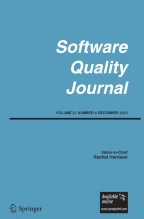Avoid common mistakes on your manuscript.
A digital society is a society in which digital technologies become the building blocks to respond to different individual, community and societal challenges effectively. Societal-scale software systems incorporate AI, include people as active players, create new information flows and reshape societal knowledge, forming entirely new environments and cities in which digital technologies are used to support and enhance our daily work, relationships, education, entertainment, industry, commerce and even politics. Thus, to create and sustain our digital society, quality is key.
Despite all its current achievements, potential benefits and future promises, there are numerous challenges to creating and sustaining a digital society. For example, socio-technical systems provide direct connections to billions of people daily around the world, which dramatically increases the potential scale for social manipulation. The adoption of new, mostly disruptive, technologies such as quantum computing or AI-based decision-making systems can bring along significant advances, but they also entail new problems since there is little understanding of how the resulting systems will behave. We also have to understand how the scale and speed of these changes impact consumers, users, citizens and workers, as well as how they affect social and private life, education, science, government, democracy and business.
The aim of this special issue of the Software Quality Journal (SQJ) is to present some of the papers that contribute to the current state of the art in the field of software quality, including methods and techniques employed by researchers and practitioners for identifying, managing, controlling, measuring and assuring quality issues in the engineering of digital societies.
Following an open call for papers, we received 17 contributions. From these, after a two-phase peer-review process (three phases, in some cases), we selected 11 articles for publication. The articles that comprise this special issue contain a common thread of how different aspects of quality are handled in modern digital society applications and domains.
-
The first article is about Web mutation testing and provides a technique to automatize the entire mutation testing process of E2E web test suites. This can be used in practice to evaluate the effectiveness of different test suites.
-
The next article is a comparative study and a proposal for API Gateway integration, and the authors present a Service-Oriented Architecture (SOA) solution for ensuring the integration of quantum software services without vendor-specific knowledge. That solution facilitates the development of quantum software applications.
-
The authors of the following article provide an exploratory study about software testing terms in existing glossaries. This study can help to harmonise such terms and improve the understanding and learning of software testing concepts.
-
The paper on a regression strategy and tool mutation proposes a novel regression mutation testing technique and tool for Solidity smart contracts. That technique boosts the mutation testing process during the evolution of smart contracts development projects.
-
In the paper on intrusion detection, the authors discuss the effect of the seed, training loss and feature selection on the performance of autoencoders for successful intrusion detection.
-
In the next paper, about improving agility in public administration, the authors attempt to investigate how public administrations can measure their degree of agility and improve such a degree based on that assessment. The results of the survey provide some insights into dysfunctionality in interdisciplinary teams as well as optimisation potential in terms of affinity to change.
-
The paper on quality aspects of forest service management investigates sociological and technical aspects of digital transformation in the context of forest service management.
-
The authors of the paper on incident response time and quantum computing apply quantum computing techniques to improve the incident response time in Information Security Management Systems that manage a large number of incidents.
-
The investigation on model-driven analysis for quality standards in software development provides an approach to automate the analysis of software development processes that must be aligned to quality standards, in particular to ISO 9001, as conducted in a case study. This solution can reduce the effort required from expert practitioners to perform the analysis and improve development processes to ensure the fulfilment of specific quality standards.
-
The paper on a micro-service based framework for cyber-physical systems presents a microservices architecture that can integrate a multi-level testing process to test CPSs. Additionally, such an architecture supports a continuous deployment, monitoring and validation of CPSs, reducing the testing effort.
-
Finally, the authors of the paper on systematic analysis of threat modelling techniques carry out a systematic literature review to achieve an overview of the automated threat modelling techniques as well as a comparison of the open-source tools that implement those techniques.
All articles have undergone a rigorous peer review process according to the journal’s standards.
As guest editors, we thank all the authors for their valuable contributions and the reviewers who helped select the papers and improve them with their thorough reviews and suggestions. We would also like to thank Elizabeth Dziubela from Springer, Paula Sonneveld and Vincent Salvo from Springer Nature, and Rachel Harrison (Software Quality Journal Editor-in-Chief) for her continuous support.
Author information
Authors and Affiliations
Corresponding author
Additional information
Publisher's Note
Springer Nature remains neutral with regard to jurisdictional claims in published maps and institutional affiliations.
Rights and permissions
About this article
Cite this article
Vallecillo, A., Perez-Castillo, R. & Visser, J. Guest editorial: special issue on “IT quality challenges in a digital society”. Software Qual J 32, 1–3 (2024). https://doi.org/10.1007/s11219-023-09644-2
Published:
Issue Date:
DOI: https://doi.org/10.1007/s11219-023-09644-2
